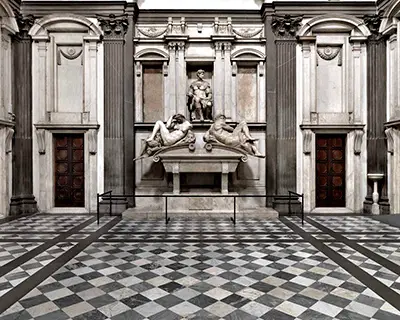Like his paintings and sculptures, Michelangelo's designs are just as impressive. His first major architecture work was the Sagrestia Nuova in Florence.
Sagrestia Nuova (New Sacristy)
The Sagrestia Nuova or New Sacristy which dates from the 16th century is located within Florence’s Basilica di San Lorenzo church. It is one of two structures known as the Medici chapels. The Sagrestia Nuova was the idea of Cardinal Giulio de' Medici and his cousin Pope Leo X. They hired Michelangelo to work on the Sagrestia Nuova and design a mausoleum for Medici family members. Its purpose was to honour the Medici family. Work on the design and build of the Sagrestia Nuova began in 1520. It went on until 1524 before starting again in 1530. The gap was in part the result of the expulsion of the Medici family from Florence.
This came about following the sacking of Rome that saw Pope Clement, a member of the Medici family no longer being in power. The Medici's regained power in Florence in 1530. In designing the chapel, the plan was also to design tombs for Medici family members. These would be the resting place for Pope Leo X's father, Lorenzo il Magnifico, and his brother Giuliano. It would also house the tombs of two other Medici family members, Giuliano, Duke of Nemours and Lorenzo, Duke of Urbino. Only the tombs of the Duke of Nemours and Duke of Urbino were finished. Each tomb has two pairs of reclining male and female statues adorning it that depict the times of the day. Giuliano’s tomb has figures representing the Night and the Day.
Lorenzo's tomb has figures of the Twilight and the Dawn. Above and looking down on each coffin is a statue of the Duke. Both figures show each Duke seated and facing the other. They are not lifelike portraits of the deceased but as pictures of two types of man - the dynamic and the reflective. The tombs sit on bases that lift the sculpted figures to above eye level. Work on the tombs for Lorenzo il Magnifico and his brother did not take place. Instead, three statutes now stand in their spot. One of the statues is of the Virgin and Child carved by Michelangelo. The carving of the other statues of Cosmas and Damian (the Medici family’s patron saints) was completed by two of Michelangelo’s pupils.
Work stopped in 1534 when Michelangelo moved from Florence to Rome where he settled permanently. When he left the work was incomplete. It wasn't until 1554 when work on the Sagrestia Nuova was restarted and finished by Giorgio Vasari and Bartolomeo Ammannati in 1555.
Sagrestia Nuova Design
In undertaking the design and construction of the Sagrestia Nuova, Michelangelo based it on the plans for the Sagrestia Vecchia (Old Sacristy). The Sagrestia Nuova sits across from Brunelleschi's Sagrestia Vecchia in the San Lorenzo. The design of each Sacristy is very similar. The New Sacristy is a cubic space that is topped with a decorative dome that has sunken decorative panels. The interior walls are an early example of Renaissance Mannerism. The use of distortion in both scale and perspective makes the architectural parts of the structure appear impossible thereby creating a sense of 'suspense and tension'. In his design, Michelangelo makes use of grey sandstone (pietra serena) pilaster elements to give the appearance of supporting columns on each of the corners. He also used them to break up the wall space into large and small compartments.
Basilica di San Lorenzo
The Sagrestia Nuova (New Sacristy) does not stand on its own but is, in fact, part of a much larger monastic complex. At the centre of Florence's market district stands the Basilica di San Lorenzo. It comprises of four religious structures. These include the architectural works:
- The Old Sacristy
- The New Sacristy
- The Laurentian Library
- The Chapel of the Princes (Cappella dei Principi)
- The Chapel of the Princes and the New Sacristy are together known as the Medici Chapels
Other Notable Architectural Works
In addition to the Sagrestia Nuova, Michelangelo is credited with having worked on other architectural works. These include such works as the St. Peter's Basilica in Rome as well as the Laurentian Library in the Basilica. His last architecture project before he died was the Santa Maria degli Angeli e dei Martiri in Rome.


